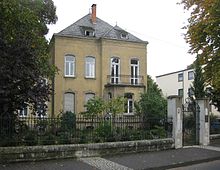Constitution for Rhineland-Palatinate
| Basic data | |
|---|---|
| Title: | Constitution for Rhineland-Palatinate |
| Short title: | Rhineland-Palatinate Constitution |
| Abbreviation: | RhPfVerf |
| Type: | State Law |
| Scope: | Rhineland-Palatinate |
| Legal matter: | Constitutional law |
| References : | BS Rh-Pf 100-1 |
| Issued on: | May 18, 1947 ( VOBl. P. 209) |
| Entry into force on: | May 18, 1947 |
| Last change by: | 38th state law amending the constitution for Rhineland-Palatinate of 8 May 2015 ( GVBl. P. 35) |
| Effective date of the last change: |
May 16, 2015 Amendment of Articles 82, 83 and 135 |
| Please note the note on the applicable legal version. | |
The Constitution for Rheinland-Pfalz ( short RhPfVerf ) is by the 18 May 1947 referendum Constitution adopted for the country Rhineland-Palatinate .
The constitution was drafted by the Consultative State Assembly , which met on November 22, 1946 in the Koblenz City Theater for its constituent session .
Emergence
After a controversial discussion, the Consultative State Assembly passed the draft constitution on April 25, 1947 and recommended it to the population. Ordinance No. 87 of the French occupying power stipulated that the referendum on the constitution should take place on May 18, 1947 together with the state elections in Rhineland-Palatinate in 1947 . In addition to the vote on the constitution as such, there was a separate vote on Section II of the constitution “Church, education and cultural maintenance”. In the event that the constitution is rejected, the newly elected state parliament should have the mandate to draw up a new constitution.
The constitution was adopted by 53% of the electorate, with a 77.7% turnout. The school article was accepted from 52.4% with a turnout of 77.4%. Major regional (and denominational) differences emerged during the vote: there were high majorities in the administrative districts of Koblenz and Trier, and narrow majorities in Montabaur. The constitution was rejected by a majority in the administrative districts of Rheinhessen and Pfalz .
The following constitutional questions were controversially discussed:
- In school policy (the separate vote referred to this), the question of Christian denominational schools was essential. While the CDU demanded the free choice of parents between denominational schools and simultaneous schools (and enforced it in the draft constitution), social democrats, communists and liberals agreed to anchor the simultaneous school as a unified school in the constitution.
- The Social Democrats rejected the creation of the state of Rhineland-Palatinate and therefore called for the constitution to be rejected. The school article also met with rejection. As a result, the Catholic minority in small parishes could demand a denominational school. This would in fact make the simultaneous school the denominational school of the Protestant majority. The Catholic minority could therefore force a denominational school on the Protestant majority.
- The KPD called for land reform and the socialization of companies to be included in the constitution and rejected the constitution because it did not contain these regulations.
- The liberal parties called for the constitution to be adopted but for the school articles to be rejected.
In the pastoral word of the Protestant church leadership of May 8, 1947 and in the pastoral word of the Catholic bishops of April 27, 1947, calls for the adoption of the constitution and the school article.
Due to the secular tradition of France, the French occupation authorities were negative about the retention of denominational schools. After the Union had made it clear that if the denominational schools were not anchored, the constitution would not receive a majority in the National Consultative Assembly, the occupying power had to accept this constitutional regulation and, in return, forced a separate vote on this regulation. The denominational schools existed in Rhineland-Palatinate as regular schools until 1968.
Proposal and structure of the constitution
Preamble
- Conscious of responsibility before God, the source of justice and creator of all human community,
- Inspired by the will to secure human freedom and dignity, to organize community life according to the principle of social justice, to promote economic progress for all and to shape a new democratic: Germany as a living member of the international community,
- the people of Rhineland-Palatinate gave themselves this constitution:
First main part: Fundamental rights and fundamental duties
Section I. The individual
- 1. Freedom rights
- 2. Equal rights
- 3. Public Duties
Section II: Marriage and Family
III. Section: Schools, Education and Cultivation
IV. Section: Churches and Religious
Communities V. Section: Self-Government of the Communities and Community Associations
VI. Section: The economic and social order
VII. Section: Protection of the natural foundations of life
Second main part: Structure and tasks of the state
Section I: The Foundations of the State
Section II: Organs of the People's Will
- 1. The Landtag
- 2. The state government
III. Section: Legislation
IV. Section: Finance
V. Section: Jurisprudence
VI. Section: Administration
VII. Section: Protection of the Constitution and the Constitutional Court
VIII. Section: Transitional and final provisions
literature
- Christoph Grimm / Peter Caesar : Constitution for Rhineland-Palatinate. Comment . Nomos Verlagsgesellschaft, Baden-Baden 2001.
- Lars Brocker / Michael Droege / Siegfried Jutzi : Constitution for Rhineland-Palatinate. Comment . Nomos Verlagsgesellschaft, Baden-Baden 2014.
- Practice of the local government of Rhineland-Palatinate, Constitution for Rhineland-Palatinate, commentary by Marc Lahmann, Udo Hans, Dr. Klaus Korger
Web links
- Text of the constitution for Rhineland-Palatinate
- Fathers of the state constitution - Adolf Süsterhenn and Ernst Biesten
Individual evidence
- ↑ reference: VOBl. P. 209
- ↑ Doris M. Peckhaus and Robert Hess: 40 Years of the Rhineland-Palatinate Parliament, 1987, ISBN 3-87439-142-6 , pages 31-34


